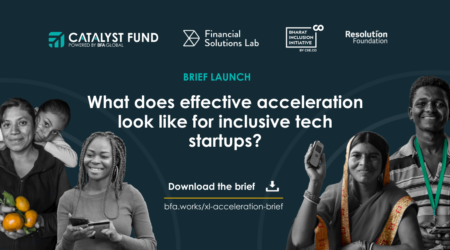How do accelerator programs approach funding for startups? Six considerations every program should evaluate

Not all startup accelerator programs are right for all founders. From the particular expertise of the acceleration team, to the types of support available, to the network of connections a program can offer, and particularly when it comes to funding structures, each is designed to fill specific gaps faced by startups. Founders considering these programs weigh the benefits and implications of each offering based on what’s best for their business. However, accelerators must also consider a number of factors, including their own sustainability and the best interest of the startups they support, when determining how they will approach funding decisions and their offering.
Catalyst Fund partnered with the Bharat Inclusion Initiative’s (BII) Financial Inclusion Lab, the Financial Health Network’s Financial Solutions Lab, and Fintech Cadence’s Innovate Financial Health Lab to form the XL Lab, a working group of fintech accelerators supported by JPMorgan Chase & Co., in order to create and share best practices for the industry. The coalition conducted research to better understand how various fintech startup acceleration programs approach funding models. We interviewed 17 accelerators from around the world that chose a range of equity, debt, and grant funding approaches. We also spoke to 14 startup founders to understand the implications of each approach on their businesses, as well as which they prefer and why.
We found that startups look for a range of funding interventions, and may pursue debt, grant, and equity investments at different stages of their journeys. They assess accelerator programs based on both the financial support offered and the implications it could have on their businesses, as well as the other non-financial benefits of these programs, notably technical assistance or venture building, training, access to networks, peer learning, etc. Startups weigh these benefits carefully, but we found that more often than not, they cannot access all the types of support they need from any single program.
Considerations for accelerator funding strategies
Accelerator programs similarly weigh several factors to decide whether to offer equity investment, debt vehicles, or grant funding to their portfolio. More specifically, we found that accelerators consider six factors when designing an approach to funding:
- Financial upside: Programs often consider their own fundraising challenges and opportunities when making decisions about what type of funding to provide to startups.
- Administrative cost and effort: The legal structure of accelerator programs can determine what type of funding they can provide, as can the skillsets and size of the accelerator team.
- Sourcing: Although most programs have more applicants than spots, the number of acceleration and mentorship programs are multiplying. As such, acceleration programs are “competing” with each other, as well as early-stage impact investors and other support programs, to recruit the best startups to their programs.
- Scale: Programs have different opinions when it comes to the type of funding that can best help startups scale, but we agree that funding can contribute to scale by de-risking future investment and filling gaps between angel and series A rounds.
- Impact: In our sample, most accelerators seek to reach underserved users, and the programs include funding as a way to accelerate the progress of inclusive business models.
- Ecosystem development: Some accelerator programs have an explicit mandate to create thriving innovation ecosystems in a particular country or region or sector, and funding structures may reflect this mandate.
The effort to balance these priorities has lead to five accelerator “archetypes”, as summarized below:
We have summarized our findings in this deck (snapshot in the table above), which takes into account the perspectives of both accelerators and founders.
Funding amounts and models offered vary based on programs’ own sources of funding, location and startups’ goals
In general, the amount of direct financing provided by accelerator programs varies dramatically — some programs offer no capital, while others in the sample offer up to $125,000. Of the 52 programs in a sample from recent research by GALI, roughly 70% provide funding (equity investments, loans, or grants). Interestingly, we found no relationship between the amount of funding provided and the type of funding model used. Those without a direct financial component in their offering are as likely to take equity as those with a large cash component.
The type of funding provided is often guided by a program’s capabilities and the source of funding for its operations. Equity stakes can be complicated legally, especially when ownership spans multiple countries. As such, the location of the program — whether in a non-profit or a private sector company — can be a determining factor in choosing which capital instrument to offer. As well, foundations/philanthropic funders cannot easily take ownership stakes in for-profit companies, and so these funders often opt for grants.
Debt is the rarest type of capital offered by accelerators. However, it can be optimal for startup models that are capital intensive or need working capital to on-lend, for example. Debt could also subsidize program costs, contributing to program sustainability, if capital is returned frequently via repayment structures adjusted to program goals.
Impact is a primary consideration for grant funding models
In some cases, a focus on impact or inclusion can also determine a program’s funding approach. Underserved users are considered more risky to serve, so more risk-taking capital is often needed to seed and test innovative businesses that can develop solutions for this segment. Moreover, such users tend to be less understood, so more data, research, and insights may be needed to develop models that can reach them successfully. In many cases, programs working with startups in this space will opt for grant funding so they can have more flexibility to push the boundaries of product innovation and target lower-income, underserved markets.
In addition, grant funding is often linked to an ecosystem agenda in which programs also focus on accelerating the broader community of inclusive fintech via a learning agenda and knowledge outputs. To broaden the impact of philanthropic funding, these programs promote an active flow of information, ideas, and best practices, to enable more entrepreneurs to access the knowledge they need and spur more innovation.
Opportunities for improvement remain for accelerators to meet founders’ needs
Our research, as well as insights from conversations that took place during a roundtable of leading accelerators, incubators, and industry experts, indicates several areas of opportunity for improvement among the community of tech accelerators:
- Startups often struggle to choose the investors that are the right fit for them: Founders mentioned finding it difficult to understand which investors they should seriously consider. Fundraising can take up a lot of founders’ time, so finding more efficient solutions for sifting through a lot of investors and identifying who would be a good partner would be valuable. Accelerator programs can consider helping startups target and vet investors more optimally to ensure they succeed in raising capital after their programs
- In emerging markets, founders dedicate significant effort to “educating” investors: In less developed ecosystems and products, entrepreneurs mentioned they often need to spend time “educating” investors about the value chains, segments, and markets in which they work. Accelerator programs can consider ways to reduce this burden for founders by delivering some of the necessary educational content and market-entry support directly to investors.
- Founders find it challenging to compare and sequence accelerator programs: Startups might have a number of accelerator programs to choose from and need help selecting which is right for them, and when. Greater coordination among accelerator programs and a clear differentiation of offerings would go a long way in guiding founders in their decision-making. A common set of terms and definitions (about stages, types of support, funding mechanisms, etc) across the industry would also improve the selection process for founders.
- Programs struggle to recruit women, local, and other underrepresented founders: Open calls for applications may be inadvertently deterring underrepresented founders. Many programs, for instance, require founders to be present on-site at a particular location, or require documentation to be in English, both of which might be difficult for some local founders in emerging markets. Programs need to consider better ways of recruiting among local, women, and other non-traditional founders, such as embedding themselves in the communities they want to reach, or ensuring they have a diverse program team that can attract diverse founding teams.
—-
XL Labs previously collaborated to distill best practices in accelerating fintech startups using 10+ years of lessons learned across the US, UK, and emerging markets. The paper on acceleration best practices can be downloaded here. The group is now working to assess approaches to measuring the impact of inclusive fintech solutions on end-customers and how programs can best support entrepreneurs in their impact monitoring efforts.


